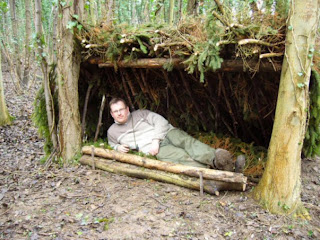As my friend Robin at Treewright has just posted in a previous thread I thought I would promote him EVEN MORE!!! by showing you something he demonstrated to me when we were working together at the Scout Jamboree last summer.
Not everyone has the materials, time or space for their own pole-lathe, but a bow-lathe is a small and simple alternative. Below is a picture of Robin in action using his bow-lathe.

I guess you could say that it is based on the principle of the bow-drill, because you use a bow to rotate your work instead of foot power as used with a pole-lathe.
All you need is a stable base (I used a piece of scaffold board for mine) and two uprights fixed securely to the base. Drill a hole towards the top of each upright and insert a coach screw (or similar) through each, having ground a point onto each bolt to hold your piece of work securely. Use two nuts to secure the bolts in position.

At one end you can incorporate a simple wooden handle to tighten one bolt to hold you work.

and finally fix a piece of wood between the two uprights as a tool rest

Now axe a length of wood into a rough "round", place the bow string around using the same method as with the bow-drill and secure your work between the two bolts.
Now using a couple of bodgers chizels, move the bow backwards and forwards to rotate your work and turn the wood into whatever you require!



 I used the end of a Birch log as a rest for safer and more secure working and ensured I was holding my work off to one side of my body when cutting to help avoid accidents.
I used the end of a Birch log as a rest for safer and more secure working and ensured I was holding my work off to one side of my body when cutting to help avoid accidents. I shaved one end flat with my knife to form the chisel.
I shaved one end flat with my knife to form the chisel.














































